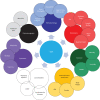Current and novel treatment options for obstructive sleep apnoea
- PMID: 35769417
- PMCID: PMC9234427
- DOI: 10.1183/23120541.00126-2022
Current and novel treatment options for obstructive sleep apnoea
Abstract
Obstructive sleep apnoea is a challenging medical problem due to its prevalence, its impact on quality of life and performance in school and professionally, the implications for risk of accidents, and comorbidities and mortality. Current research has carved out a broad spectrum of clinical phenotypes and defined major pathophysiological components. These findings point to the concept of personalised therapy, oriented on both the distinct clinical presentation and the most relevant pathophysiology in the individual patient. This leads to questions of whether sufficient therapeutic options other than positive airway pressure (PAP) alone are available, for which patients they may be useful, if there are specific indications for single or combined treatment, and whether there is solid scientific evidence for recommendations. This review describes our knowledge on PAP and non-PAP therapies to address upper airway collapsibility, muscle responsiveness, arousability and respiratory drive. The spectrum is broad and heterogeneous, including technical and pharmaceutical options already in clinical use or at an advanced experimental stage. Although there is an obvious need for more research on single or combined therapies, the available data demonstrate the variety of effective options, which should replace the unidirectional focus on PAP therapy.
Copyright ©The authors 2022.
Conflict of interest statement
Conflict of interest: W. Randerath reports receiving payment or honoraria for lectures, presentations, speakers’ bureaus, manuscript writing or educational events from Weinmann, Heinen & Löwenstein, Resmed, Jazz Pharmaceuticals, Inspire, Philips Respironics, Bioprojet, and Vanda Pharma; and support for attending meetings and/or travel received from Heinen & Löwenstein, Resmed, Jazz Pharmaceuticals, Inspire, Philips Respironics and Bioprojet; participation on a data safety monitoring or advisory board for Bioprojet, Jazz Pharmaceuticals and Philips Respironics. He is Head of European Respiratory Society Assembly 4 (Sleep Disordered Breathing) and an associate editor of this journal. J. Steier is a named inventor on a patent for KCL/GSTT (Apparatus for treatment of snoring and sleep apnoea; WO2016124739A1) outside the submitted work. J. Verbraecken reports grants or contracts received from Philips Respironics, Heinen & Löwenstein, ResMed, Total Care, Fisher & Paykel, Bioprojet, Jazz Pharmaceutics, AirLiquide, Total Care, Westfalen Medical, Somnomed, Medidis, Wave Medical, OSG, Mediq Tefa, NightBalance, Accuramed, Bekaert Deslee Academy, UCB Pharma, Vivisol and Inspire Medical Systems, outside the submitted work; consulting fees received from Vemedia; payment or honoraria for lectures, presentations, speakers’ bureaus, manuscript writing or educational events received from Sanofi, Agfa-Gevaert, Astra-Zeneca, TotalCare, Springer and OSA Academy; support for attending meetings and/or travel received from Bioprojet; participation on a data safety or advisory board for Bioprojet, Oxford Pharmagenesis, Idorsia, MSD and Desitin. He was President (until August 2021) and is Past President of the Belgian Association for Sleep Research and Sleep medicine (since September 2021), and is an associate editor of this journal. The remaining authors have nothing to disclose.
Figures






References
-
- Randerath W, Bassetti CL, Bonsignore MR, et al. . Challenges and perspectives in obstructive sleep apnoea: report by an ad hoc working group of the Sleep Disordered Breathing Group of the European Respiratory Society and the European Sleep Research Society. Eur Respir J 2018; 52: 1702616. doi:10.1183/13993003.02616-2017 - DOI - PubMed
Publication types
LinkOut - more resources
Full Text Sources
Research Materials
